I had been talking with a good friend (Alan) on the local ham radio repeater and he mentioned that I needed to stop by and check out some of his new “stuff” that he had added to his tool bench. Alan had gotten some new equipment to do A/C work on the current R-134a systems like I have in the TJ. That sounded like a great opportunity to try out the new equipment and check the performance of my A/C system at the same time. My TJ has been on the road for just under 8 years now and although the vents still blow cold air, I can tell it’s not as cold as it once was.
Since my A/C was blowing cool air, I expected no major problems with the system. If I had a significant leak of any kind, there would be no cool air at all as the refrigerant would have leaked out. When that happens, the low pressure cut-off switch prevents the compressor clutch from engaging.
The first part of the tune-up was getting the equipment attached to the TJ. That meant attaching the two hoses (high and low) of the A/C pressure gauges to the service ports on the TJ’s air conditioning system. The gauges are used to measure the high and low pressures in the system. Tables in the factory service manual indicate the operating pressures for properly charged system.
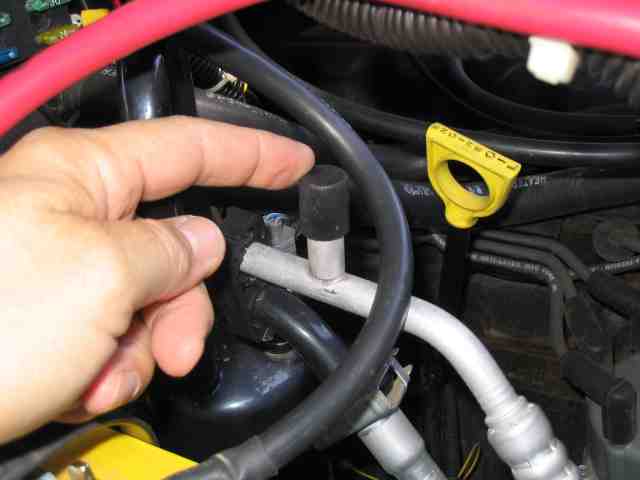
The low pressure port, shown above, is located between the dip stick and the battery on the a/c low pressure line.
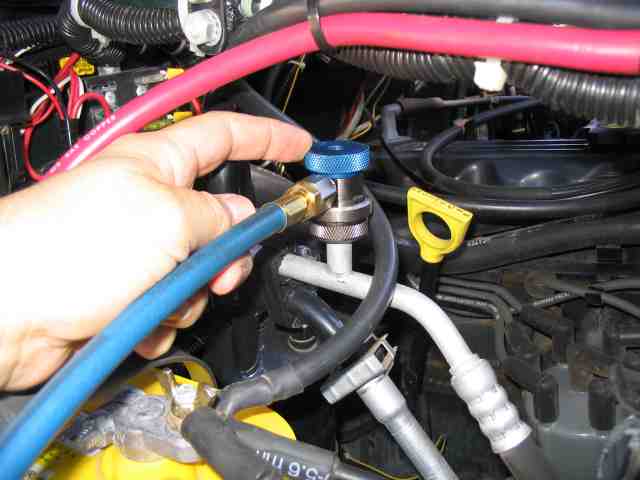
I unscrewed the cap from the service port and snapped on the low pressure coupler to the port. It is a quick disconnect coupler that simply snaps onto the low pressure port. The low and high pressure ports are different sizes to make it simple to get the correct hose attached to the right port.
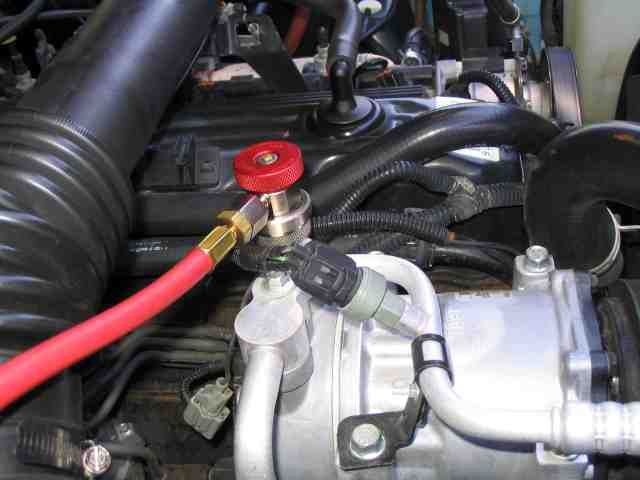
After finishing with the low pressure port, I attached the high pressure hose to the high pressure service port. This port is located right at the the compressor on my TJ. It too has a screw off cap that I removed before the high pressure hose was connected.

The remaining hose that is attached to the gauge manifold is connected to the refrigerant container. Alan had a partially used can, about 3 ~ 4 ounces remaining, already attached to the hose so I set the can in a safe place to keep it out of the way. The valve on top of the can will be opened if we determine the system is low on refrigerant.
Air Conditioning Tune-up
With the low (blue side) and the high (red side) hoses now attached to their respective ports on the TJ, I opened the valves on the service port couplers. The valves there are used to “trap” the refrigerant in the hoses so that when you remove the hoses from the system, you do not release refrigerant into the environment. When I opened these valves, it actually connected the hoses to the a/c lines in the Jeep.

Next, I opened the two valves on the gauge manifold. With these now open, I could read the static pressure (compressor is not running) on the a/c system. It was sitting at approximately 120 PSI.
The on the ambient air temperature affects the pressures you will read when running the compressor. The tables in the factory service manual span a range of air temps in 10 degree steps. We turned on the digital thermometer that Alan uses and found our ambient temp was just a bit over 90 degrees. Close enough….the 90 degree column in the pressure table would suit our needs just fine.
According to the manual, I would be expecting a low pressure of 38 to 47 PSI and a high pressure of 250 to 300 PSI if the system was charged with the proper amount of refrigerant. The center vent temperature should be in the 37 to 48 degree F. range.

It was time to start the engine, set the A/C to recirculate, and put the blower fan to high the setting. After several minutes of operation, I checked the pressure gauges. As shown above, the low pressure gauge was 30 PSI and the high pressure gauge was about 205 PSI. The center vent temperature was about 57 degrees.
As we suspected, the system appeared to be a little low on refrigerant. It wouldn’t take too much to bring the numbers up into the proper ranges by adding a little refrigerant.
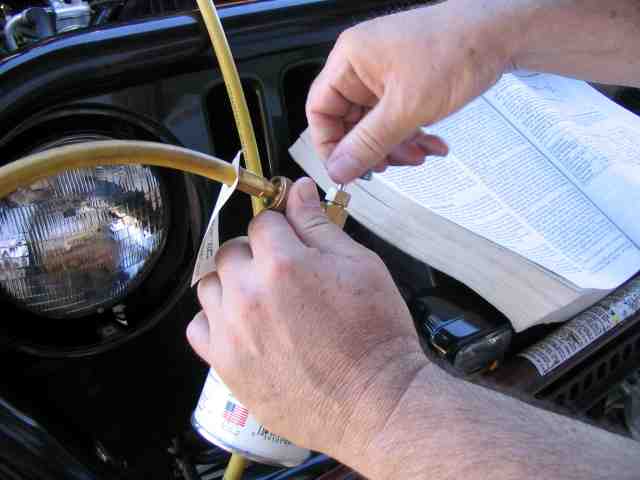
With the engine and compressor still running, Alan opened the valve at the top of the R-134a container. I saw an immediate jump on the low pressure gauge. Alan said this is normal as we are now seeing can pressure on the low pressure side. Immediately, the can began to get cold….a sure sign that refrigerant was being transfered from the can into the low pressure line.
To speed the process along, I set the hand throttle to about 1400 RPM. After another 30 seconds or so, Alan closed the valve on the R-134a container so I could get an accurate reading on the gauges. We were better on the numbers but still a bit below what the manual said we should get, so the valve was opened again to add a bit more refrigerant.
I was keeping an eye on the digital thermometer that we had pushed into the center vent. It was slowly dropping as we added refrigerant. When it hit the 45 degree point, Alan closed the valve on the R-134a can and I took another look at the gauges. That was better…..low pressure was hitting about 41 PSI and the high pressure reading was a bit over 250 PSI. We agreed that it was pretty good and I was happy with the numbers we were seeing. Yeah, we probably could have added another ounce of refrigerant, but 45 degree air was OK with me.
The valves on the gauges and couplers were closed (trapping the R-134a refrigerant in the hoses) and I removed them from the A/C service ports. Alan shook the R-134a container and estimated that there was an ounce or so left which meant we added about 3 ounces to the system.
That 3 ounces probably doesn’t seem like much, but as you can see, it was enough to bring the system into spec and drop the temp by 10 degrees. An important point here….it would be VERY easy to overfill the system with just a 12 oz. can of refrigerant if it were in the same situation as mine….a little low but still making cool air. Alan said that the old R-12 systems were more forgiving and could tolerate being over filled more than the R-134a systems. I am glad he had the gauges available as it provided us with an accurate method by which to accomplish this maintenance work.
Unless something down the road indicates otherwise, I should be good for a few more years (with any luck) before I need to do this again. Of course, anything can fail and if it does, I guess I’ll be doing something else to fix the problem.
Air Conditioning Tune-up
Although we didn’t need anything other than the gauges and a few ounces of refrigerant for the tune-up, Alan has a few other items for more advanced A/C work, should they be needed.
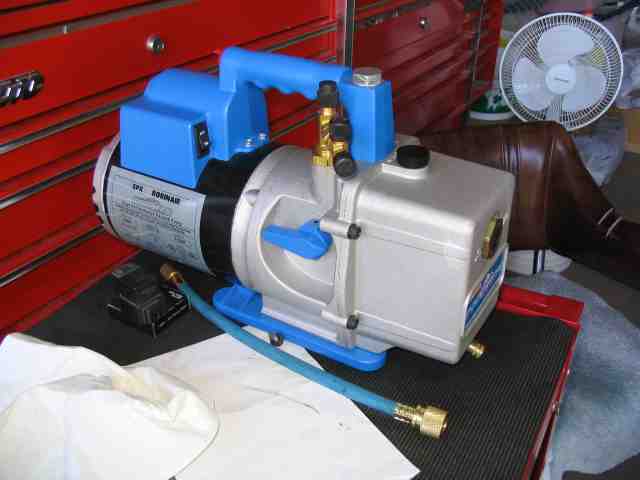
If the A/C system has a major leak or an item is replaced due to failure, a good vacuum pump is needed to completely evacuate all of the air from the system before refrigerant is added. Alan said this one will pull a vacuum down to about 20 microns (which is about as void of air as you can get without getting into some serious equipment).

In order to accurately determine the amount of air left in the system when the vacuum pump is running, Alan uses a digital gauge that is thousands of times more accurate than a mechanical dial gauge. After the vacuum pump has evacuated the air from the system, the pump valve is closed and this gauge monitors for any leakage. The LEDs on the gauge light up and indicate just how air tight your system really is.
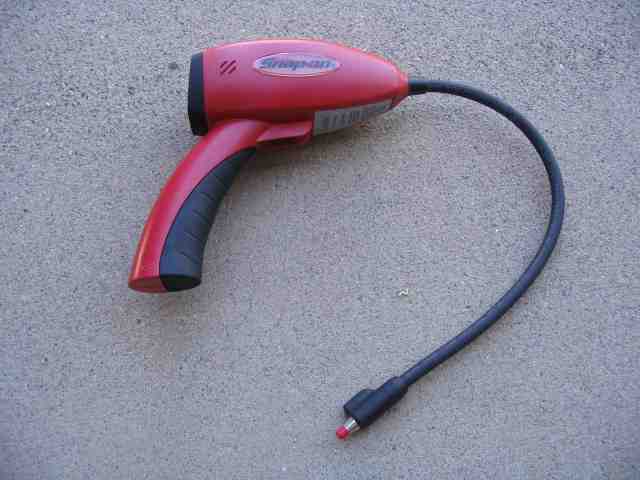
This little beauty came from the folks at SnapOn tools. It is a refrigerant detector that also contains a UV light source used to illuminate UV refrigerant die. When you turn it on, a small pump draws a very small amount of air through the flexible hose and the unit “sniffs” for extremely tiny amounts of refrigerant.
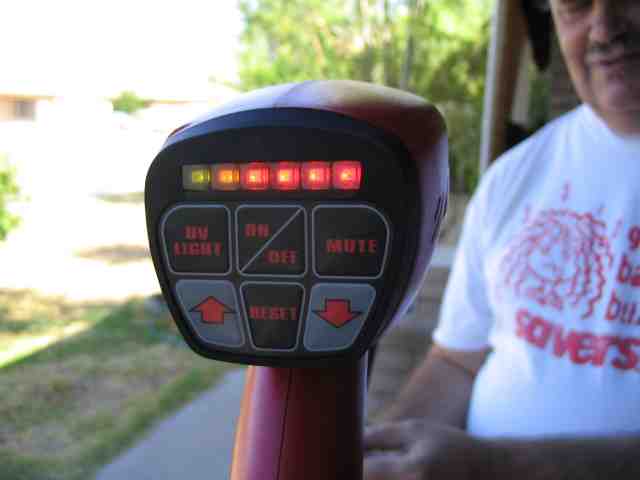
As a demo, Alan grabbed a gauge hose and placed the port coupler near the end of the sniffer. Wow….it lit up, as you can see, light a Christmas tree! I can see where this would be invaluable when you had a tiny leak in the system and you were trying to determine where it was. You can also add UV detectable die to add to the refrigerant system which when leaked out, can be seen with the UV light and special glasses that come with the sniffer. Neat tool!
Well, that is about it for this write-up. For those that were wondering, a reasonably priced set of R-134a gauges runs about $100 to $150. It doesn’t take too many trips to the local A/C fix it shop before you can recover the cost of the gauges, if you decide to go that route.
